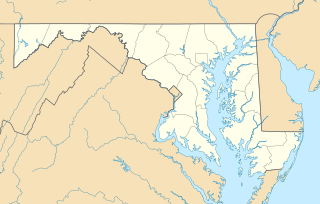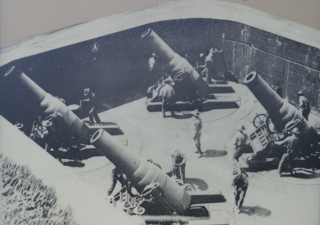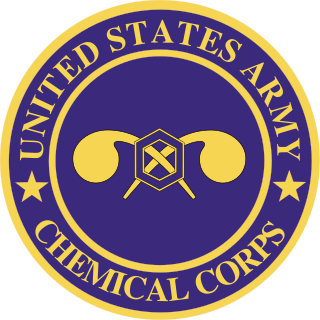Related Research Articles

Biological warfare (BW)—also known as germ warfare—is the use of biological toxins or infectious agents such as bacteria, viruses, insects, and fungi with the intent to kill or incapacitate humans, animals or plants as an act of war. Biological weapons are living organisms or replicating entities. Entomological (insect) warfare is a subtype of BW.
Biodefense refers to measures to restore biosecurity to a group of organisms who are, or may be, subject to biological threats or infectious diseases. Biodefense is frequently discussed in the context of biowar or bioterrorism, and is generally considered a military or emergency response term.

Fort Detrick is a United States Army Medical Command installation located in Frederick, Maryland. Historically, Fort Detrick was the center of the U.S. biological weapons program from 1943 to 1969. Since the discontinuation of that program, it has hosted most elements of the United States biological defense program.
Biopreparat was the Soviet Union's Scientific Production Association and major biological warfare agency from the 1970s on. It was a vast, ostensibly civilian, network of secret laboratories, each of which focused on a different deadly bioagent. Its 30,000 employees researched and produced pathogenic weapons for use in a major war.

The United States is known to have possessed three types of weapons of mass destruction: nuclear weapons, chemical weapons, and biological weapons. The U.S. is the only country to have used nuclear weapons in combat, when it detonated two atomic bombs over the Japanese cities of Hiroshima and Nagasaki during World War II. It had secretly developed the earliest form of the atomic weapon during the 1940s under the title "Manhattan Project". The United States pioneered the development of both the nuclear fission and hydrogen bombs. It was the world's first and only nuclear power for four years (1945–1949), until the Soviet Union managed to produce its own nuclear weapon. The United States has the second largest number of nuclear weapons in the world, after the Russian Federation.

The United States Army Medical Research Institute of Infectious Diseases is the U.S Army's main institution and facility for defensive research into countermeasures against biological warfare. It is located on Fort Detrick, Maryland and is a subordinate lab of the U.S. Army Medical Research and Development Command (USAMRDC), headquartered on the same installation.

Operation Whitecoat was a biodefense medical research program carried out by the United States Army at Fort Detrick, Maryland between 1954 and 1973. The program pursued medical research using volunteer enlisted personnel who were eventually nicknamed "Whitecoats". These volunteers, all conscientious objectors, including many members of the Seventh-day Adventist Church, were informed of the purpose and goals of each project before providing consent to participate in any project. The stated purpose of the research was to defend troops and civilians against biological weapons and it was believed that the Soviet Union was engaged in similar activities.
William C. Patrick III was an influential microbiologist and bioweaponeer for the U.S. Army during the Cold War.
The National Center for Medical Intelligence is a component of the Defense Intelligence Agency (DIA). The role of NCMI is described in DoD Instruction 6420.01. Headquartered at Fort Detrick, Maryland, NCMI's mission is to monitor, track and assess a full range of global health events that could negatively impact the health of U.S. military and civilian populations.

Fort Terry was a coastal fortification on Plum Island, a small island just off Orient Point, New York, United States. This strategic position afforded it a commanding view over the Atlantic entrance to the commercially vital Long Island Sound. It was established in 1897 and used intermittently through the end of World War II. In 1952, it became a military animal and biological warfare (BW) research facility, moving to civilian control in 1954 as the Plum Island Animal Disease Center. However, the biological warfare mission continued under civilian control until 1969, when the US ended offensive BW research. The island is now being considered for sale or conversion to a wildlife refuge.
The National Biodefense Analysis and Countermeasures Center (NBACC) is a government biodefense research laboratory created by the U.S. Department of Homeland Security (DHS) and located at the sprawling biodefense campus at Fort Detrick in Frederick, MD, USA. The NBACC is the principal U.S. biodefense research institution engaged in laboratory-based threat assessment and bioforensics. NBACC is an important part of the National Interagency Biodefense Campus (NIBC) also located at Fort Detrick for the US Army, National Institutes of Health and the US Department of Agriculture.

The Chemical Corps is the branch of the United States Army tasked with defending against chemical, biological, radiological, and nuclear (CBRN) weapons. The corps was founded as the U.S. Chemical Warfare Service (CWS) during World War I. Its name was changed to the Chemical Corps in 1946. For most of its history, the Chemical Corps was tasked with delivering chemical weapons rather than defending against them.
The United States biological weapons program began in 1943 and was discontinued in 1969.
Erich Traub was a German veterinarian, scientist and virologist who specialized in foot-and-mouth disease, Rinderpest and Newcastle disease. Traub was a member of the National Socialist Motor Corps (NSKK), a Nazi motorist corps, from 1938 to 1942. He worked directly for Heinrich Himmler, head of the Schutzstaffel (SS), as the lab chief of the Nazis' leading bio-weapons facility on Riems Island.
Ira Lawrence Baldwin was the founder and director emeritus of the Wisconsin Academy Foundation. He began teaching bacteriology at the University of Wisconsin in 1927 and a few years later moved into what became a career in administration. He held positions as chair of the Department of Bacteriology, dean of the Graduate School, dean and director of the College of Agriculture, university vice president for academic affairs, and special assistant to the president. He was also involved in programs for agricultural development both in the United States and abroad. Among Baldwin's many achievements was a review of Rachel Carson's Silent Spring, titled "Chemicals and Pests" in the journal Science.

The U.S. Army Biological Warfare Laboratories (USBWL) were a suite of research laboratories and pilot plant centers operating at Camp Detrick, Maryland, United States beginning in 1943 under the control of the U.S. Army Chemical Corps Research and Development Command. The USBWL undertook pioneering research and development into biocontainment, decontamination, gaseous sterilization, and agent production and purification for the U.S. offensive biological warfare program. The Laboratories and their projects were discontinued in 1969.

The Deseret Test Center was a U.S. Army operated command in charge of testing chemical and biological weapons during the 1960s. Deseret was headquartered at Fort Douglas, Utah, a former U.S. Army base.
The "Statement on Chemical and Biological Defense Policies and Programs" was a speech delivered on November 25, 1969, by U.S. President Richard Nixon. In the speech, Nixon announced the end of the U.S. offensive biological weapons program and reaffirmed a no-first-use policy for chemical weapons. The statement excluded toxins, herbicides and riot-control agents as they were not chemical and biological weapons, though herbicides and toxins were both later banned. The decision to ban biological weapons was influenced by a number of domestic and international issues.
The War Bureau of Consultants (WBC) was a committee of 12 prominent scientists and several government consultants put together in November 1941 to investigate the feasibility of a U.S. bio-weapons program. The bureau's recommendations led to the creation of an official U.S. biological weapons program during World War II.
The United States biological defense program—in recent years also called the National Biodefense Strategy— refers to the collective effort by all levels of government, along with private enterprise and other stakeholders, in the United States to carry out biodefense activities.
References
- National Academies: Committees on Biological Warfare, 1941-1948
- Cutting Edge: A History of Fort Detrick (Chapter 4)
- ↑ Luther E. Lindler, Frank J. Lebeda, George Korch, Biological Weapons Defense: Infectious Diseases and Counterbioterrorism, Humana Press, 2005, ISBN 1-58829-184-7, p. 156
| This United States government–related article is a stub. You can help Wikipedia by expanding it. |